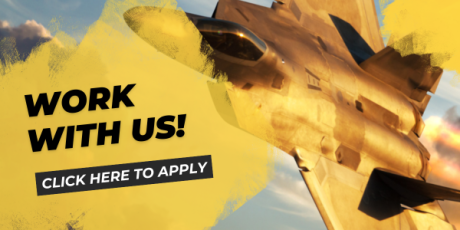From his youth, Jack Northrop imagined efficient all-wing aircraft so advanced that technology and power plants needed to support them efficiently were not yet available.
Jack Northrop
John “Jack” Northrop was born in 1895 in Newark, New Jersey, and grew up in Santa Barbara, California. Jack lived in the area where, in their infancy, aircraft companies were beginning to form. In his youth, at age 16, Jack witnessed a pilot on his lawn assemble a home-made aircraft, resulting in Jack deciding he could design an aircraft better than what he had watched his neighbor assemble. Jack had experience working for his father in his construction business, worked as an architectural draftsman, and had experience working as a garage mechanic while in school. At this early age, he had impressive mathematic and drafting skills for someone without a college education. He sketched many ideas of his own aircraft designs.
Jack learned of an aircraft project near the garage he was working in and often visited the Loughead brothers of Allan and Malcolm who were building the plane. He offered his services providing engineering drawings as well as computations to assist the brothers with their construction process. Eventually Northrop was hired on as a draftsman with Loughead’s Aircraft Manufacturing Company. Jack worked there until he was drafted during World War One but he was later assigned back to Loughead due to his skills in aviation design. However, Loughead Aircraft would close in 1920.
Malcolm Loughead formed the Lockheed Hydraulic Brake Company in 1919, a four-wheeled braking system installed by Walter P. Chrysler on the Chrysler car in 1924. Malcolm used the phonetic spelling of his last name to avoid confusion. The Lockheed Hydraulic Brake Company was sold to Bendix in 1932. In 1926 Allan Loughead, along with Fred Keeler, Kenneth Jay, and Jack Northrop, founded the Lockheed Aircraft Corporation. The “Lockheed” spelling was used in order to associate the company with the successful brake company Malcolm had established. Jack Northrop would be the chief engineer of the company. Allan Loughead would legally change his last name to “Lockheed” in 1934. Northrop would design the famous high-wing monoplane known as the Vega while working at Lockheed.
Northrop became frustrated at the lack of support for his flying wing ideas while at Lockheed, and left the company in 1928. He and accountant Ken Jay formed Avion Corporation to pursue Northrop’s concepts of flying wings and advanced all-metal construction. Avion’s Model 1 was developed in 1929. The Model 1 was a smooth airframe devoid of rigging and biplane wings that were standard on aircraft of the day. The Model 1 consisted of a stressed-skin metal wing with an open cockpit. Power came from 90 horsepower Cirrus inline engine that drove a pusher propeller via a shaft. Retaining tail booms and fins with a tailplane, the design eventually became knowns as the “Northrop Flying Wing.”
The aircraft first flew in 1929. Refinements to the design included replacing the pusher engine with a front-mounted Menasco A-4 power plant, rudder extensions, and modifications to the landing gear. The aircraft had impressive performance and maneuverability compared to contemporary designs and test flights continued until Sept. 22, 1930. Avion was purchased in 1929 by United Aircraft and Transport Corporation and renamed Northrop Aircraft Corporation, later to be absorbed by Boeing. In 1932 Jack formed the Northrop Corporation in a partnership with Douglas. Labor issues led to the end of the Douglas relationship in 1937, and the plant Northrop had used in California became the El Segundo Division of Douglas Aircraft.
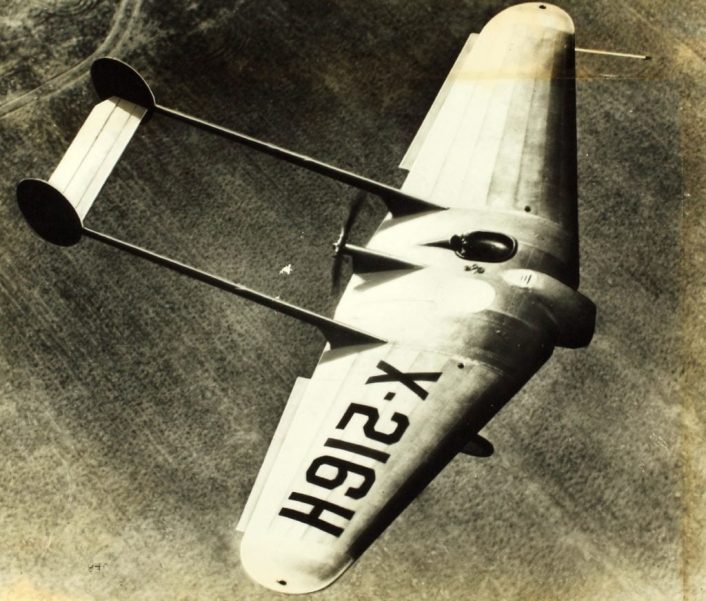
Northrop Aircraft Inc. and the N-1M
After spending years working for others, founding and selling companies, and after obtaining the funding and talent, Jack Northrop founded Northrop Aircraft Incorporated, opening it in 1939. The humble beginnings of the company were in a bright yellow building that was a former hotel/brothel and infested with black widow spiders. Yellow would be the chosen color for Northrop’s test aircraft, and the successful P-61 night fighter the company produced during World War Two would be known as the “Black Widow”.
The company’s first flying wing design, designated the N-1, was also the first company-financed research project. The aircraft completed in the summer of 1940, would be a sub-scale mockup of a medium bomber used as a proof-of-concept demonstration aircraft, leading to the designation of N-1M (mock-up). The N-1M had a wingspan of 38 ft, overall length of 17 ft and weighed 4,000 lbs. The wingtips drooped and could be manually adjusted on the ground at different angles for airframe stability testing. Wing dihedral, sweepback, and twist were also all adjustable for testing purposes.
Power came from two engines that were upgraded to Franklin 6AC264F2 models generating 117 HP each, from the initial Lycoming 65 HP engines. Two twin-bladed pusher props were driven by 10 ft shafts from the engines buried in the aircraft. The engine upgrade improved flight and altitude performance during tests at Baker Dry Lake. Test flights continued into 1943, the N-1M making approximately 100 test flights. Northrop’s concept of a flying wing had been proven. The aircraft earned the nickname “Jeep” due to the all-yellow paintjob mimicking the yellow “Eugene the Jeep” of the popular Popeye comics of the time. The N-1M is on display, restored, at the Smithsonian National Air and Space Museum Steven F. Udvar-Hazy Center in Chantilly, Virginia.
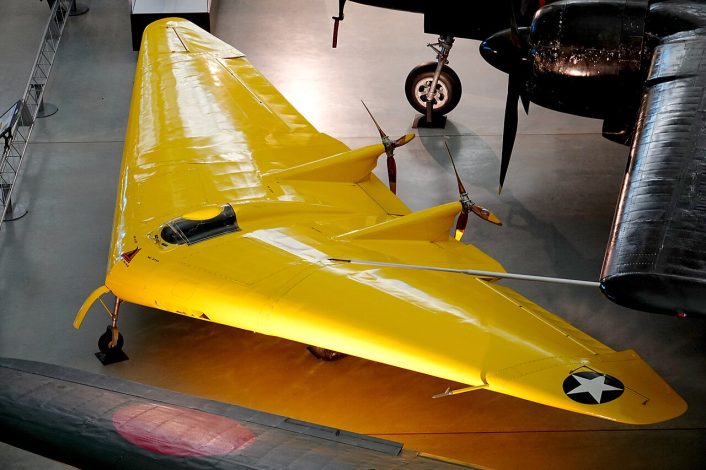
A pilotless offshoot of the N-1M project was the JB-1 and JB-10 (Jet Bomb) concepts similar to the German V-1 buzz bombs powered by pulse jet engines. Intended range was around 200 miles and the weapons demonstrated good flight characteristics, in spite of numerous control issues and the lack of suitable and reliable power plants. While somewhat of a departure from the initial flying wing design, the weapons developed so much ground effect lift it was sometimes very difficult to land. This would become a familiar trait of some of Northrop’s later and larger designs.
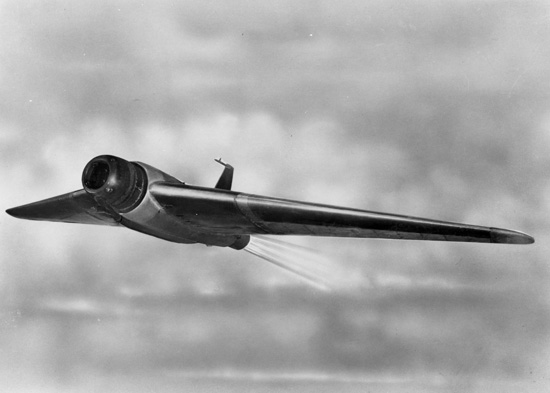
Additional Flying Wing Concepts
Other flying wing concepts from Northrop included the N-2B/XP-56 Black Bullet, which would be the first aircraft to utilize pusher contra-rotating propellers. Powered by a single engine, the bullet-shaped design housed an air-cooled engine buried deep in the fuselage. The aircraft featured vertical fins below and above the tail, along with turned-down wingtips. Being propelled by pusher-type props, in the event of pilot bail-out, an explosive charge would jettison the propellers and gearbox in order to provide pilot safety.
The aircraft was constructed using a magnesium alloy due to the scarcity of aluminum during wartime. Northrop’s team developed a welding technique in which magnesium could be welded without bursting into flames, using an environment of helium, called heliarc. Designed with the intent to reach speeds of over 500 mph with a piston engine-powered aircraft, the XP-56 would have been heavily armed but suffered stability issues and was never placed in production. Two experimental prototypes were built, the first one crashing in 1943; the second aircraft is in storage with the Smithsonian Institution’s National Air and Space Museum.

Jack Northrop was also responsible for America’s first rocket-powered aircraft when a flying wing glider, the MX-324, fitted with an Aerojet General 2,000 lb thrust rocket motor, was air-towed by a P-38 twin-engine fighter and released. The engines were fired and test pilot Harry Crosby and the “Rocket Wing” made the United States’ first rocket-powered aircraft flight on July 5, 1944. Previously, Harry had made a memorable flight in the unpowered glider version, the MX-334, when upon release from the P-38 the yellow glider caught the fighter’s propeller wash and began to spiral earthward inverted. Crosby was able to escape the cockpit from his prone position, and seated himself on the underside of the inverted glider as it fell earthward, eventually sliding off and parachuting down, the glider continuing to circle inverted in its descent.
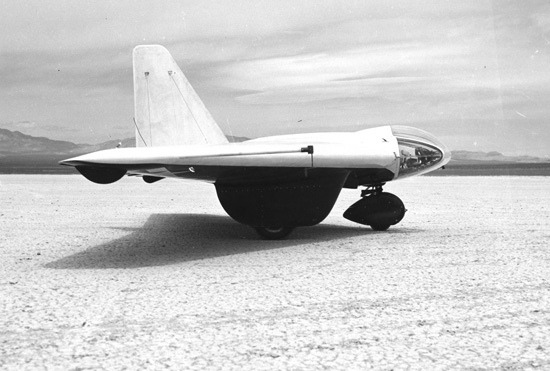
Building off the experience and lessons of the MX-324, Northrop designed the XP-79 (NS-140) as a rocket-powered interceptor. Again the pilot was placed in the prone position, with a chin-rest supporting him as he looked forward out the transparent nose section from a cramped cockpit. Controls that were foot operated included rudder and airbrakes, with pitch and roll controlled by a handheld crossbar. The rocket engines proved troublesome and the fuels dangerous, resulting in the XP-79B, which would instead be powered by two Westinghouse 19B (J30) turbojets. This also saved about 5,000 lb in weight.
Two vertical stabilizers were also added by the builder of the aircraft, Avion (a coincidence of the same name of Northrop’s former company). Steel plates had been added to the leading edges of the wings of magnesium construction to protect the volatile fuel tanks of the rocket-powered version, and were said to be reinforcements to allow the jet-powered version to ram and cut enemy aircraft. Armament was to be four .50 caliber machine guns outboard of the wing intakes. Speed was estimated to be in excess of 545 mph, with a range of almost 1,000 miles and a ceiling of 40,000 ft.
The XP-79B may have made an effective bomber escort and interceptor had World War Two continued into 1946. The aircraft made its first and only test flight on September 12, 1945. Harry Crosby was at the controls when the aircraft went into a slow roll and never recovered. Crosby attempted to bail out but was struck by the aircraft and killed. The first and only test flight of the XP-79B lasted 15 minutes, and the program was ended.
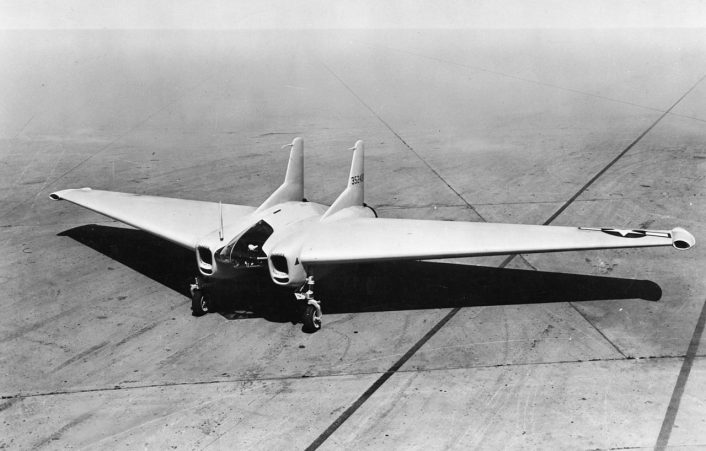
Stay tuned for the second part of this article coming soon online, when we will take a look at the big wings: the XB-35, YB-49, and of course, the B-2 Spirit.








